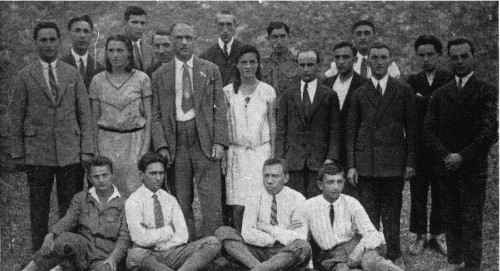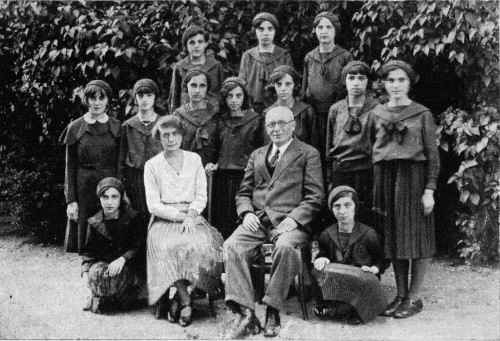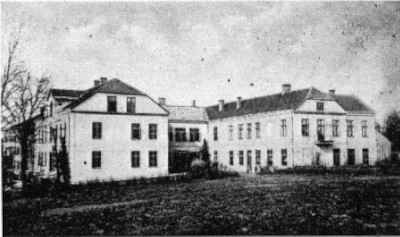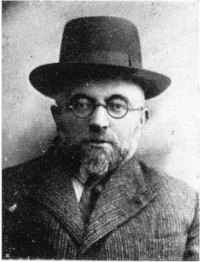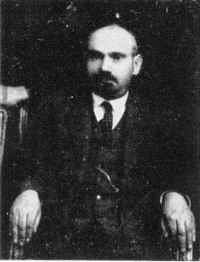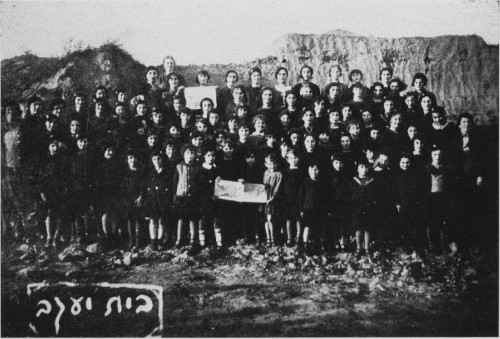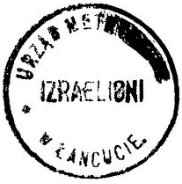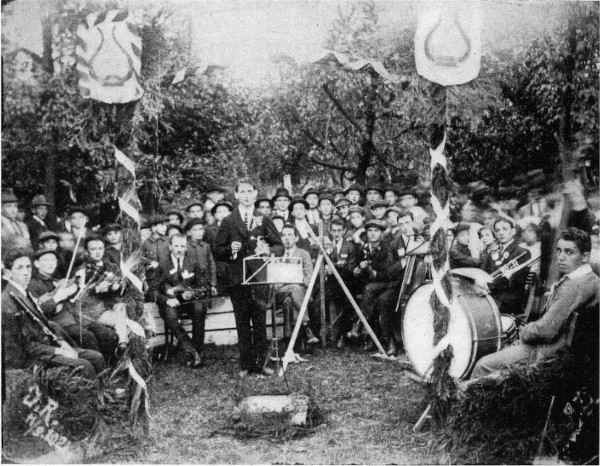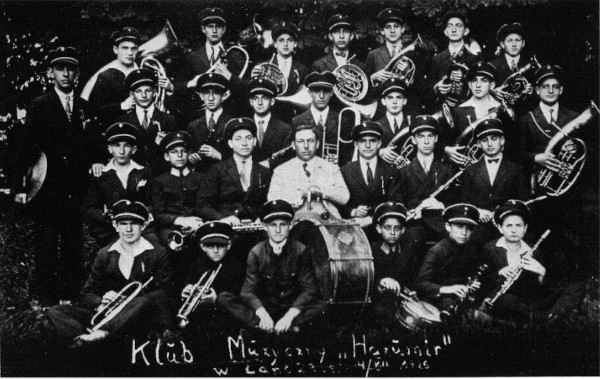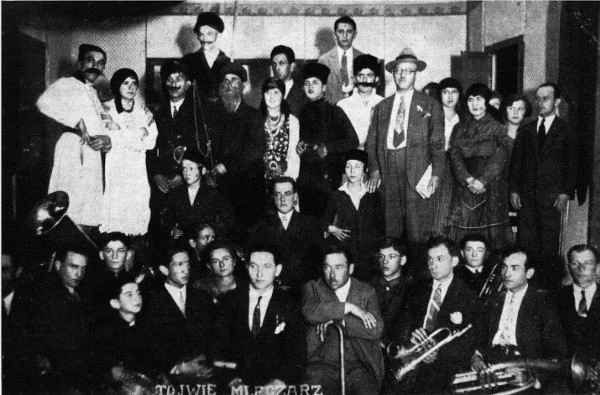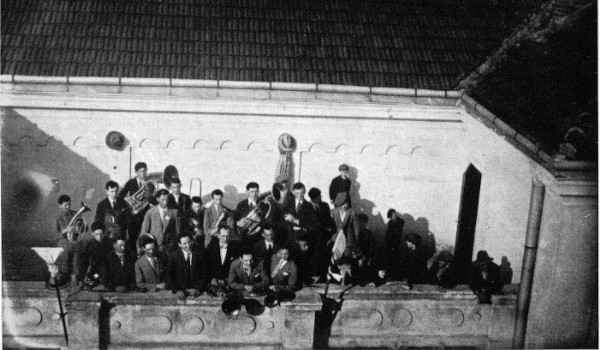Culture and Education
[Pages 113-114]
The resurrection of the Hebrew Language in Lancut
Dr. Natan Kudish, Tel-Aviv
The writers of the history of the new Hebrew literature had determined that Reb Moshe Chaim Luzato (Ramacha'l), who appeared 100 years ago, was the beginner of the new Hebrew literature period.
The central and eastern European Jewry served as a fertile ground for the growth and blossoming of the new Hebrew literature for every political orientation. The might “Haskalah” movement engulfed the Jews in all of the above countries. After the decline of the “Haskalah” in Germany and Austria, a shiny new period of new Hebrew literature had spread throughout Poland, Lithuania and Russia.
Within the background of Hassidism and “Mitnagdut”, the “Haskalah” fulfilled the revolutionary task, in the process of the social and national renaissance of the Easter European Jewry. The Haskalah poets and its writers had revived the language of the Bible and showed the masses of the house of Israel, the splendour and glory of the Bible World and the path to amend their social and national lives.
The new Hebrew literature, with its different political orientations during the romantic, rational and national periods, within poetry, story-telling, philosophy and thoughts and publicity, brought to life the “Chibat Zion” movement and the love of the Zion language which was restored to its youth. However, the readers of the new Hebrew literature and the Hebrew press although fluent in Hebrew, were not Hebrew-speaking people. The intellectuals who knew how to read and write Hebrew, did not use the language in their daily life.
It was only at the end of the 19th and the start of the 20th century and having being influenced by the organized Zionist movement, inspired by the resettlement and rebuilding of Eretz Israel, were the first sounds of the Hebrew language heard from the “Lovers of Zion”, intellectuals and then the vision of realization began throbbing in their hearts.
* * *
The Hebrew intellectuals and the Zionists in Galicia were the Hebrew speaking pioneers. In many big and small cities in Eastern and Western Galicia at the start of the 20th century, groups were organized among which the revival and the spreading of the Hebrew language was their goal. What as the share of Lancut in the movement of the language revival? Lancut was blessed of possessing all the needed conditions to have associations and institutions whose goal was the revival of the language, spreading and familiarizing it among the people starting with tiny tots, studying and working youth, Beit Hamidrash dwellers and finally among the adult Zionist and intellectuals.
Lancut was not virgin ground that needed ploughing and planting the seeds for revival of the language. Layers and layers of ancient Jewish culture, wisdom and Jewish folk's life were immersed in the community for generations. The revival of the Hebrew language in Lancut among the young people added a new cultural and national layer, which sprouted from an organic sprout of cultural, Torah and secular heritage of Jewish Lancut.
Before Dr. Herzl appeared on the arena and before the foundation of the World Zionist organization, there already was, in Lancut, a Zionist Association, “Ahavat Zion” which was founded in 1894 with dozens of organized members. At the same time, there was also a group of Hebrew intellectuals who had concentrated around the known intellectuals such as Yitzhak Weisman and Joseph Meir Rosmarin.
In the first decade of the 20th century, Zionism put down roots in Lancut. Zionist institutions were established and the number of intellectuals that left the Beit Hamidrash, increased. However, Hebrew was not a spoken language yet. It was only spoken by a few individuals, among which was the most outstanding person, the old-timer, Getzel Druker, and among the younger people, there was David Yust, Shlomo Greenbaum, Yechiel Nusbaum, Shimon Rosenblit and leading the group, was the known scholar and intellectual, Anshel Katz.
After World War I and after the Balfour Declaration which laid the foundation of rebuilding the land which led to the third pioneers' emigration, only then did the National Zionist conscience gain strength among the European Jews. The spiritual and National Zionism expressed itself in the newly revived Hebrew language which was spoken by the elite of the Jewish national youth in Eastern Europe.
Before World War I, there already was in Galicia, writers and educated cultural activists who urged Hebrew lovers to organize associations with the goal of reviving and adopting the language in their daily lives. Outstanding in this activity were: A.M. Lipshitz, Dr. Joshua Thon, Dr. Ehrenpresi, Dr. M. Broida and Tzvi Carl.
The association was named “Ivriyah”. World War I ended this weak creature, however, in the 20's after the end of the war, the “Ivriyah” association was organized anew and there was an association in almost every major Jewish populated Galician city.
In Lancut, the Hebrew language was heard from the mouths of the young students and average youth who concentrated in “Hashomer Hatzayir”, of which the main speaker was Aaron Kerner.
The strongest and most important nucleus of Hebrew speakers were among the young people which originated from the Yeshivot and the Beit Hamidrash that had absorbed the ancient literature and had joined the Zionist movement, enjoying the aroma of the new Hebrew literature. They became the bearers of the vision about the revival of the Hebrew language, fulfilling the mitzvah of speaking Hebrew. This young group in our city had managed to build a strong foundation for spreading the Hebrew language among the younger generation. They established the first Hebrew school for the children of Lancut. It is worthwhile remembering the following school teachers: Alter Graubart, Nathan Warhaftig, Budner, Lederman and Zeinvel Hammersfeld. The first popular Hebrew library was established and groups of youngsters were organized for those whose yearning of “Eretz Israel” and for those who strove to revive and use the Hebrew language in their daily lives.
The young people, who were particularly enthusiastic about the Hebrew language were the following: Nachman Kestenbaum, Shmuel Greizman, Getzel Estlein, David Baumel, Tzvi Birnbaum, Chaim Habenshtreit, Gizela Gliksman, Sheindl Stempel, Ryvka Bot, (the translator's first cousin), Ryvka Tzviebel, Chava Shtelcer, Batyah Wolkenfeld, Sarah Lipshitz, Shimon Wolkenfeld, Michael Walzer, Moshe Rosenblit and Yitzhak Greenbaum.
|
|
The writer, Daniel Perski with a group of members of the “Ivriyah” Association
Sitting from right: Shalom Rosmarin, Naphtali Reich, Yitzhak Greenbaum and Michael Walzer
Standing from right, first row: Dolek Trumpeter, Michael Shiper, Nachman Kestenbaum, Henia Greizman, Daniel Perski, Manka Mechlowich and Leizer Fass
Standing, second row: Joshua Mendel Wolfman, Yitzhak Celner, Moshe Rosenblit, Eliyahu Reich, Joseph Seifert, Moshe Trompeter and Tzvi Sauerhaft |
In the “Ivriyah” organization and its activities were conducted strictly in Hebrew as well as lectures and plain chit-chats. Sometimes the members of the association would put on plays in Hebrew. Those who came to the association were young people, male and females alike. Some came to borrow a book and some came to listen to the Hebrew conversations. The dream of the Hebrew language brought the young people to the modes room of “Ivriyah” which was next to the “Zion” library, and it looked like both were wrapped into one. They came from every segment of the population and from different circles. Beit Hamidrash dwellers, who were still sitting, bent over the “Gemara”, peeked into the books of Mapu, Smolenskin, Achad Haam and Bialik. Some were influenced by the books and some were not. A young girl from an Orthodox home and who also read a Hebrew book secretly, fearing the anger of her father who was afraid she might get spoilt. Young male and females from the pioneers' movements, took upon themselves the Hebrew language preparedness which they knew would be needed in Eretz Israel. Students in Polish gymnasiums, who diligently studied in the secular schools, drank thirstily from the books of poetry of Bialik and Tchernichovsky.
The readers were from different ranges. There was no absence of intellectuals who knew how to intertwine Judaism with humanity. There were also newlyweds whose day times were occupied in their business but their souls yearned for the spiritual world and the beauty of the Hebrew literature that had recently been revived.
Hebrew school graduates, Tzvi and Peninah Sauerhaft, Moshe Rozenblit, Yitzhak Greenbaum, Michael Walzer, David Trumpeter, Israel Just, Henia Greisman, Peninah Margal and Tovah Shtelcer, founder of a youth organization with a library named “Neurim”, adding another layer to the building of the Hebrew culture in the city.
All the people mentioned above had dreamt about a complete redemption of the Hebrew culture in the old-new homeland. However, not everyone of these people merited to see the realization of their dreams not the complete revival of the Hebrew language. They perished by the hands of the Nazi murderers and their helpers.
Their memory should be engraved in the hearts of the natives of Lancut, and their souls be bonded with the dreamers of Hebrew revival.
[Pages 115-117]
Education in Lancut
Michael Walzer
An editorial board was established in Lancut to publish a book about the city gymnasium. I sent an article for the book on the Jewish part in that gymnasium which played an important role among the Jewish youth of Lancut, especially among the Jewish students in the gymnasium which was about 5% of the total numbers of students.
If we want to review the education or the Jewish school in Lancut, we would have to go back to the period before the destruction until the 18th century.
Lancut excelled with its intellectuals and the fostering of education in the city was at its highest level.
The variety of the education
Speaking on Jewish education, I am obliged to mention the various education of the Jewish youth. The “Cheder”, which practically served all the children. Part of them in the early stage of their education, or a little higher, and for part of them, it served a complete education and nothing else. Suffice to say I will bring up the personality of the teacher, “Berish” Einhorn. He was a “Melamed” (teacher) for many years and educated several generations. He died at the age of 84 in 1935 at his son's, Shmuel Einhorn's home, after he had moved to Rzeszow in 1928, where he continued in his profession. His wife Hinda died several years before him. Reb Berish's “Cheder” was located in Rzeszow, quiet a distance, but he walked to the place daily in spite of his age and even in the coldest day.
|
|
| A group of female students in the public school with the teacher, Fabian Ebner |
A little bit of history
In 1788, A Jewish public school was established in Lancut, initiated by Herz Homberg. Shlomo Ostreicher was hired as a teacher with a salary of 200 crowns.
In the beginning of the 19th century, Count Alfred Potocki established a network of public schools throughout Galicia. As a resident of Lancut, he especially devoted himself to the education of the children of his city. He sent students from Lancut abroad to study at his expense. He urged the student to learn trades and prepare themselves to become managers of enterprises, qualified professionals, leaders of agriculture farms and workshops. He also selected the talented among the students to become artists, enrolling them into art schools.
The son of the Count, Alfred Joseph Potocki, was minister for agriculture in the Austrian government in 1868 and had introduced improvements on his estate. He employed a famous agronomist, and in time, founded an agricultural school in the area.
For the advancement of intellectuality in Lancut and bringing it nearer to the modern world at that time, needs had to be taken under account of the following factors: In the 19th century, in 1831, after the French revolution, aristocratic refugees and immigrants from France arrived in Lancut. The failed Polish rebellion in the 19th century brought many rebels to settle in Lancut and in the area, with the help of Count Potocki. These types of refugees had an influence on the spirituality of the place.
In the Polish geographical dictionary (Part 8, page 579, Warsaw 1884) among other matters, it was stated: “Lancut stood out from any other city in Galicia with its cleanliness and with its numbers of intellectuals”.
Here are a few chronologic details of education in Lancut in those days: In the 2nd half of the 19th century, the language used for teaching in school was German. The number of pupils in school was low and obligatory education did not exist.
In 1864, the monks established a school which, in time, turned into a general public school. From that time on, we an expense item in the budget of the city of Lancut, that supported the school. In 1876, the one-story school building was built. Due to crowding and the increase in students, many classes were taught in the city offices. At that time, we came across a personality by the name of Boleslaw Zardecki, a Polish education activist in Lancut, who was a major activist in fostering education in the city.
The public school was divided into two parts: A separate school for boys and a separate school for girls. In time, the education progressed and the initiators were again the monks that came to Lancut and founded a Seminary for female teachers with a dormitory.
At the end of the 19th century, there was an agriculture school in the village of Olbigowo which was known throughout Poland. In the village of Brakszawa, there was a textile school with a dormitory, in a large two-storey building with 250-300 students.
The Gymnasium that was named after the poet Sienkiewich
|
|
| The State Gymnasium Building |
The old -time gymnasium in Lancut bearing the name of Sienkiewich, was also connected with the above-mentioned activist, Boleslaw Zardecki, who was a member of the Austrian Parliament and a resident of Lancut. He used his influence when he was in the financial committee. He received official help and recognition of the gymnasium with the condition that the city of Lancut would contribute 55,000 crowns for the building and upkeep of the school. He building was erected on the city land in Lancut. The contribution and help from the city authorities was very appreciated considering the complicated budgetary hardships which they had at the time.
Hebrew school and gymnasium personalities
I still visualize the typical personalities of the Hebrew school teachers and from the gymnasium. Teachers whose way of life was not regular because of the deception of the times that had transferred them to different and unusual paths. The teacher Kahane was the first teacher in the Hebrew school in our city in 1913, in the framework of “Teaching Hebrew” when the Hebrew school was organized in 1919 as a full-sized school.
Alter Graubart, an only son to rich parents, at the age of sixteen, was ordained and was qualified to become a Rabbi. His parents owned wine storage rooms and their entrepreneurship reached all the way to Hungary. Due to a fire and the death of his parents, this erudite, pampered young man was forced to work for a living. He, therefore, became a teacher who taught The Talmud, ritual laws, “Tosefta” (a supplement of Mishna), Bible, literature and Hebrew history.
|
|
|
|
| Teacher Zeinvel Hamersfeld |
|
Teacher Abraham Lederman |
In 1928, the teacher Lederman arrived from Tchortkow. Besides being a teacher in the Hebrew school, he devoted a lot of his time to cultural activities. He was an active member in the “Ivriyah”, a lecturer, speaker and participated in many cultural conventions.
Zeinvel Hamersfeld worked as a teacher in the Hebrew school from 1935 until the outbreak of World War II.
As was said before, the Hebrew school was a complementary education. The main education of the progressive young people was the governmental school. From the total number of students in the public school, 30% were Jewish. There were fewer Jewish students in the city gymnasium. They had hardship to adapt to the study conditions in the city gymnasium because the school taught on the Sabbath, during the services in the synagogue.
Among the first teachers in the gymnasium was professors Shmider and Malinek, with a long beard (I am in contact with a relative of his in connection with the publication of the memorial book for the gymnasium).
Dr. Koler, who was a teacher in the gymnasium, is remembered by the Lancut natives especially because the turning point in his life occurred when he decided to emigrate to Eretz Israel. During the pogrom in Lancut in 1918, the windows in his room were shattered which he refused to repair but patched them up with newspapers as a “remembrance of the destruction”. From this occurrence, he derived his conclusion to emigrate to Eretz Israel after World War I. He established a middle school in Tel-Aviv. He became a pioneer of middle education in Eretz Israel after World War I. He died in 1955. His son, Dr. Dov Koler, is a lecturer at the Jerusalem University.
Dr. Nathan Kudish, a member of “Ivriyah” had passed his exams in the Lancut Gymnasium which was named after “Sienkiewicz” (a Polish writer and poet) as an extern student. While being a student in the gymnasium, he was also a “private” teacher of Hebrew. He emigrated to Eretz Israel in 1934. He, at present, is the principal of the government school “Bar Kochba” in Tel-Aviv. He publishes articles on the subjects of education and teaching in pedagogic periodicals. The mathematic teacher, Shtern and the religious teacher, Fabian Ebner, perished in the Holocaust.
The first Jewish students were: Moshe Shtecher and Leon Rubin from Kolbuszowa, (they live in the USA), David Wowchi Rozenbach, Joshua Kesten and a few students from Boraszczow and Buchach.
This is how the education of the young Jewish people in Lancut can generally be described since the period when the nobility had escaped the French revolution and found shelter and safety in Lancut. They laid the foundation of educational institutions in our city for the young generation. They opened new horizons for education and progress. For the Jewish youths, this was a period for a special historical chance to obtain wisdom and knowledge.
However, after the “Haskalah” period of enlightenment, the gruesome period of the Holocaust followed which destroyed everything except a few sprouts and buds that survived and bear fruit in the land of the Jewish People.
[Page 118]
Bais Yaacov
Benjamin Einhorn
After World War I (1918), an urge had awakened among the young Jewish people in Poland, to belong and be organized in a youth movement of various political and ideologic persuasions and parties. The urge also included the desire to obtain intelligence and knowledge. At the same time, daughter had also begun to enrol en mass into government, public and private schools.
|
|
| Pupils of a Jewish school for girls, “Bais Yaacov” |
In view of the above occurrence, the organized Orthodox religious circles decided to open schools for girls from Orthodox families in order to keep them away from secular youth movements and provide them with a traditional-religious education. The above occurrence gave the push for the opening of a net of schools for girls which was called: “Bais Yaacov”.
One, very active woman, who was active in the field of education within the framework of “Bais Yaacov” schools, was Sarah Shenirer, of blessed memory, from Krakow. The administration for her was so great that she was called “Mother Shenirer” by her pupils.
After many difficulties and financial effort, a “Bais Yaacov” school was founded in Lancut. Within two years, the number of girls that studied in school reached to over 100. Shortly thereafter, a kindergarten was established for the ages 3-6, which was a branch of the “Bais Yaacov”. About 80 children attended the kindergarten.
Two committees, one man and one of women had supported and helped with the existence and the development of the school and the kindergarten. It is fair to mention and recall the members of the men's committee which were as follows: Reb Leibchi Korn, Reb Feivush Adolph, Reb Yitzhak Helmreich and Reb Moshe Shternheim. The existence of the two educational institutions were impressive upon the Jews of Lancut and it can be stated that they caused some kind of a revolution in certain Jewish families.
The girls who had received their education in the “Bais Yaacov” school were taught the knowledge of the Torah of Moses, the basic knowledge of ritual laws and attained a religious-traditional way of life in their future. Educating these girls was very fruitful. From its ranks later came many devoted activists who participated in every activity of the “Agudat Israel”, whether it was for an immediate need, locally, or later useful for the people in Eretz Israel. Their memory shall be blessed.
[Page 119]
“Daat” “Wiedza” (Knowledge) Library
Magister Eliezer Dishe, Herzliyah
With the broadening of the Zionist Organization's activities in Lancut, mainly among the Jewish youths, their striving to attain enlightenment and education in the general schools had increased especially in the gymnasium. It has to be understood that there were many obstacles to overcome in order to enrol in the gymnasium because of anti-Semitism, which had increased in the middle of the 20's. There were also financial hardships, hence the Jews of Lancut had not been known to be rich. There was one more serious religious problem, namely attending school on the Sabbath and Jewish holidays. The majority of Jews in Poland were observant and could not agree that their son, or grandson, should attend school on the Sabbath and holidays. It should not be ignored the pain of Jews when returning from the Sabbath services with their “Talis” bag under their arms to encounter a young Jewish boy walking home from school carrying his book satchel.
There was an average of 500-600 students in the gymnasium but there were only about 20-30 Jewish students. The relationship between the Polish students and the Jewish students in the school were cool and sometimes even hostile. All the outbreaks of anti-Semitism in the land had immediately found its way into the local gymnasium. The teachers, with the priest, had not bothered hiding this animosity toward Jews and often demonstrated their fresh faces to the Polish pupils, and the results were clear. Our Polish colleagues had tried to excel their teachers. That is why it was clear that in such an atmosphere, there were no contacts after classes (except on rare occasions) between Polish students and the Jews out of the school walls.
This was the source of a void feeling in not having a library which could help not only the Jewish gymnasium students but also the intellectuals in the city which numbers increased daily. Beside the classic books of the Polish literature which was required to be read in school in every class, especially during exams before graduation, there was a need in a translated book from the Jewish world literature into Polish in addition to all kinds of Zionist periodicals for young people. There was a huge demand for such periodicals.
The beginning of this beautiful activity which had a blessed result, ought to be credited to Mrs. Ebner who allowed the use of her room with her bookcase to the library, and the rest of the books were collected from the first subscribers. Every Sunday afternoon, Anda and Sever Ebner exchanged books to the readers. For the money which the subscribers paid (5 groszy/week/book) new books were purchased.
The library kept expanding as the thirst for reading and enlightenment increased. The number of subscribers had increased so much that it could not accommodate the crowd during the book exchanges. Managing the library, accommodating the crowd, repairing torn books, cataloguing and purchasing new books was handled by the gymnasium students and was always transferred to the new and younger generation, because the older students were leaving after graduating.
The expansion of the library overran every expectation. After another bookcase was installed in the crowded room of Mrs. Ebner, we began searching for a public location which would satisfy the need of the library's growth and enable us to exchange books more than once a week. We were lucky that in 1925, the band “Hazamir” was reorganized under the conductorship of Morris Feilshus, and the rehearsals took place twice a week in a room on the first floor of Eliezer Milrad's building on the “Third May Street”. This room was also used as a prayer place for the city's intellectuals and religious Zionists. This was also the room which was used by several public-cultural institutions. That is where the library of “Wiedza” had moved into. We bought two bookcases which were immediately filled with thousands of library books. Then the exchange of books began to take place twice a week, on Sundays and on Wednesdays between four and six in the afternoon.
The library existed in this place for five years but alas, this place became too small and a man came to our rescue – a man upon which we always could rely on when public needs were concerned. This was the leader of the Jewish community, the late engineer Abraham Spatz. He gave us permission to move the library to the meeting room of the Jewish community where the bookcases occupied an entire wall of the room. We made an effort not to interfere with the secretarial work of the community secretary. Even when subscribers appeared during working hours of the secretary, Moshe Halperin did not protest. He understood the situation and accepted it.
Finally, the library's wandering ended when the Bait Haam began concentrating all Jewish cultural facilities of the Lancut Jews in its building. The library was in possession of original copies and translations from the world of beautiful literature including Jewish, Polish and Yiddish periodicals. The contribution to increase the level of cultural and intellectual levels of the Lancut Jewry was tremendous.
With the destruction of Lancut Jews, the end of the “Wiedza” library also ended books that had educated an entire generation.
[Pages 120-122]
And this is the history of “Hazamir”
Michael Walzer
Natives of Lancut remember with pride the “Hazamir” orchestra that accompanied the youths in the city during the years between the two World Wars. The orchestra, during its carrier and at different stages, beginning with string instruments, followed by brass instruments, is interwoven and linked with the history of our city. They visited and appeared in many Galician cities. The musicians and their companions wore special ceremonial uniforms and caps, adorned with blue-white ribbons, created a Zionist-Eretz Israel spirit in every place they
|
|
“Hazamir” Orchestra in 1921
A picnic with the participation of the Orchestra
Sitting from right: Joseph Har, Shimon Anfang, Glancberg, Kalman Wolkenfeld, Mania Liftman, Abraham Sheinman, the conductor Moshe Fleilshus, Berish Wolkenfeld, Chaim Milrad, Hersh Stitzel and Leib ShtecherSitting from right: Joseph Har, Shimon Anfang, Glancberg, Kalman Wolkenfeld, Mania Liftman, Abraham Sheinman, the conductor Moshe Fleilshus, Berish Wolkenfeld, Chaim Milrad, Hersh Stitzel and Leib Shtecher |
visited. There was a time when the number of strong orchestras reached forty members and the brass orchestra had 35 members besides a sizeable number of trainees. The orchestra was affiliated with the Zionist organization “Hashachar” and rehearsed in their quarters.
The people who were involved in the orchestra and those who were its members, will never forget the “Hazamir” because there was an exalted goal to instil the art of music among youngsters to which they remained devoted to all their lives. They were not paid for their performance and if there was any income, it was dedicated to buying note sheets and instruments. Indeed, the “Hazamir” orchestra had gained recognition even among the gentiles, and at times, performed during Polish festivities, at military events when members were required to wear military uniforms according to military rules. The artistic level was very high. Music lovers, artists who demonstrated ability and talent, occasionally joined the orchestra. There were also artistic members that became musical artists and a few became orchestra members in Eretz Israel. Of course, there were fiery activists which, without their activity, the orchestra would not have existed in a normal way. For members of “Hazamir” who are no longer with us, who fell victims to the gruesome Holocaust, this article will serve as a monument to an art institution of the Lancut Zionist youths.
Musical Lancut
Reviewing the history of “Hazamir”, it is incumbent to mention all the Lancut orchestras that travelled in Galician cities, appearing at a variety of events. This generation remembers four orchestra in our city, and they were as follows. The Lancut military orchestra, the firemen's orchestra, the orchestra of the count Potocki and of course, the “Hazamir” which was affiliated with the Zionist organization, “Hashachar”. It is also proper to mention orchestras of school students and the choirs of adults and children with conductors Aba Meir for the adults and Gitl Sheinman for the children which were short-lived.
The ”Hazamir” was founded on 15th May, 1914 by Tzvi Ramer, Berek Landau, Aryeh Stitzel, Moshe Stitzel, David Har, Ely Belfer and Abraham Sheinman. At that time, the orchestra performed on the 20th day of the month Tamuz, at the memorial meeting for Dr. Herzl. Natives of Lancut who are still alive, remember how they could hardly play the following songs: “Al Eym Hadrech”, “Chushu Achim Chushu” and the “Hatikvah”. The local Rabbi, Elazar Spira attempted to boycott the orchestra because boys and girls had gathered together. World War I stopped the activity of the orchestra but it was renewed in 1919 with the addition of new members.
The strengthened of artistic power
That year, Moshe Feilshus, a talented trumpet player, arrived in Lancut from France. He was the first soloist in the Paris opera. Because of his talent, he was released from captivity. He wholeheartedly joined the “Hazamir”, became the conductor for many years and trained an entire generation of pupils. The Trumpeter brothers were both members of orchestras in Eretz Israel. Calek Spatz, Shimon Anfang, Aryeh Wiener, Abraham Margal and others too. Until 1921, it was only a light string orchestra. Beginning 1921, the brass orchestra was founded thanks to the initiative of Moshe Feilshus and Shimon Wolkenfed, God should avenge their innocent blood. The orchestra started with seven members and by 1924, there were already 37 musicians besides tens of students who were learning to play musical instruments.
Acquiring musical instruments from Czechoslovakia
There is an interesting story as to how we acquired musical instruments from Czechoslovakia by appealing to President Masarik in 1923. We asked him to discount the custom duty and everything else that was involved in purchasing the musical instruments. He warmly responded and we were awarded a discount of 33%. We paid $1750 for the instruments. The Czechs shipped the instruments by train without charge. In contrast, the Polish customs refused to give us any discount and forced us to pay the full duty.
Nevertheless, we presented Poland our services as much as we could. We performed during National Holidays and responded to every call.
We played in military orchestras
Members in “Hazamir” of military age, after being inducted into military service, had joined the military orchestras and some even reached the ranks of assistant conductors.
One of the first performances, after reactivating the “Hazamir” took place in the Berger theatre in Rzeszow. It was playing the “Three Gifts” by J.L. Peretz. The author of the play was present in the audience. There was tremendous applaud for the “Hazamir” and we were called back several times for encores. Yehuda Leib Peretz approached the members of the orchestra to shake hands with each one of us. His face was radiant and happy when he said: “This is a happy day in my life to see such a beautiful orchestra in the city of Lancut. Be strong and continue to play music among the Jews”.
“Hazamir” has performed in many Galician cities under the batons of Feilshus, Wolkenfeld, Remer and Shenman.
From the orchestra “Folklore”
An asset such as this in a Jewish city sometimes caused pleasant surprises. Such surprises happened to “Hazamir” several times. They contributed to the “Folklore” pleasant chapters. One episode is connected with the cavalry regiment that was based in Lancut. The regiment orchestra was supposed to give a performance for Polish aristocrats. The members of the orchestra were aware of the talented Zionist “Hazamir”, so they borrowed from us a few musicians, dressed them in military uniforms with all the needed badges and they performed together after which they harvested many applauds.
In 1921, there was another episode. The Rzeszow military orchestra was supposed to play during a horse race of a cavalry regiment and the military authorities turned to the leader of the “Hazamir” orchestra, engineer Shpatz, God should avenge his innocent blood, and offered to pay all expenses that “Hazamir” should perform during the races. Within hours, 20 musicians were recruited. The orchestra performed during the races and in the evening, at the dance party in the casino. The “Hazamir” members were dressed in the regiments' uniforms and general Rozwadowski expressed his gratitude with warm words.
Another episode connected with the dance party of “Gwiazda”. The military orchestra from Jaroslaw was supposed to play. All the other orchestras were busy at the time and, suddenly the Jaroslaw band were told that because of something that had happened, the Jaroslaw orchestra would not be playing at the party. This time, they again turned to the “Hazamir” at the last minute. The musicians were urgently summoned and they played with success and did not ask to be paid for their performance. However, all the above episodes did nothing to change the Polish relationship toward the Jews. Once, the Zionist organization wanted to rent the Polish clubhouse “Sokol” for an evening dedicated to Shalom Aleychem and they were flatly refused saying: “We don't rent the house to Jews”.
“Hazamir” was devoted to its designation. It was founded for the Jewish population and performed in all instances, wherever they were needed free, for the benefit of the needy, charity institutions, helping the indigent and the sick. In some cases, they were paid and exclusively used the payment for purchasing note sheets and instruments.
All members and students paid 1 zloty a month as membership dues.
In memory of the pioneers
After Tzvi Remer went to Germany, it was decided to tie the “Hazamir” with his name and at the same membership meeting, engineer Shpatz was elected director, Dov Wolkemfeld assistant director and treasurer, who was very active in stabilizing the institute financially.
In the beginning, the rehearsals of the orchestra were held in the quarters of the “Hashachar' Zionist organization. They later moved to the Hebrew School. When Tzvi Remer returned from Germany having being expelled after the ascent of the Nazi, they rehearsed in his home where he leased a small buffet for a livelihood. In time, the rehearsals were held in the Beit Haam in a specially assigned room for the orchestra.
Adjacent to the orchestra, there was a rich musical notes library, rich in quality and quantity and also with rare manuscripts. Remer, who organized a native of Lancut organization during his stay in Germany, kept in contact with the orchestra, sent expensive musical notes and helped as much as he could. He was wholeheartedly devoted to the orchestra.
“Hazamir” was the foundation stone that crystalized the youths of Lancut. It was an attractant artistic institution where all the young people found a common language. It was refined national-cultural discovery. Everyone felt that this Jewish institute brought respect and recognition for the Lancut Jewry, and as such, it enshrined in our hearts forever.
As mentioned above, the orchestra performed in Jewish and non-Jewish events, on birthdays of count Potocki, in concerts, parties and during theatre plays. The involvement of the city people in the “Hazamir”, resulted, that the entire city was immersed in Jewish music which was heard from every door and window. The orchestra members, the students, pupils and all those who dreamt of joining the “Hazamir” practiced with their own instruments at home. The city atmosphere was saturated with music.
|
|
The “Hazamir” Orchestra
Bottom row from right sitting: Michael Walzer, David Fast, Joseh Sheinman, Meir Milrad, Akiva Landau and Leib Wiener
Second row sitting: Moshe Rosmarin, Abraham Milrad, Shimon Wolkenfeld, Engineer Abraham Spatz, conductor Moshe Feilshus, Marsel Spatz and Yechezkiel Birnbaum
Standing first row: Shimon Anfang, David Trompeter, Shimon Shtrum, Moshe Rozenblum, Yeshayahu Gersten, Leib Shtecher, Moshe Mondshein and Menachem Sheinman
Standing second row from right: David Rozenblit, Abraham Halperin, Shlomo Popiol, Tzvi Sauerhaft, Abraham Margal, Yeshauahu Stempel and Zeinvel Yasem |
At the end of Yom Kippur day, the orchestra “Hazamir” use to visit Rabbi Lerner's home, who was a musician. He took out his violin from the case and the orchestra members tuned their instruments. The traditional music of Yom Kippur was played until the late hours of the night. Echoes of music were heard in a distance from our city and from each Jewish home. These echoes are still ringing in our ears and awakens in us, dreams and … hope. At the outbreak of the last war, the orchestra property was transferred to the Polish military.
The people who laid the foundation stones for the “Hazamir”: Tzvi Ramer, Dov and Shimon Wolkenfeld, were all killed during the Holocaust, together with all sacred victims of the community.
[Page 123]
Theatre amateurs' association
(Drama circle)
Nachman Kestenbaum
Lack of an auditorium to present shows and for public meetings was an obstacle to the development of the cultural life in the city. This was the reason why only second-class troupes ever visited Lancut.
Cultural activists in the Zionist organization were the first to bring up the idea to build a “Beit Haam” where social and cultural life of the Lancut Jews should concentrate.
A drama circle was founded whose goal was to make the Jewish population become closer to drama literature in Yiddish and also make funds available to build a “Beit Haam” with an auditorium for staging plays. And that is the story on how a drama circle came into existence which included not only young talented artists but also cultural activists who helped to achieve the goal. Namely, building a stage in the auditorium in a “Beit Haam”.
A lot of effort was invested in the theatre amateurs' society until a troupe came to life that was able, even under difficult conditions, to stage a show for the audience.
The circle began with small plays in a room at the Jewish community offices located above the mikvah. The Orthodoxy furiously opposed because of its location. They even influenced the Rabbi to declare a boycott of the shows. The drama circle was forced to look for another location for their performances. Having no choice, they rented a storage room where soldiers with their horses were lodged. Before each performance, the drama circle members had to clean the stable and build a stage. From the stable, they moved to the quarters of the Paley Zion Society and afterward, they continued to perform in the Polish auditorium of the “Gwiazda” club for a high-priced rent. The hall had a stage but the amateurs had to provide decorations and equipment needed for each performance, which they borrowed from their families. The “Hazamir” orchestra helped the drama circle by playing during the intermissions.
It was not an easy matter to put together a show. They started staging plays of Moshe Richter, Latainer and others. After a group of good actors was formed in the amateur circle, the society dared to appear in front of the public with serious plays. Gitl Feilshus-Sheinman and Shlomo Rozenblum had shown their talent in comedy. Gitl Feilshus continued to act even after she was already a mother of two children. Both awoke enthusiastic laughter in the audience with their performance. From among the members of the drama circle, the following should be mentioned: Tzvi Kezshtecher, Shmuel Zawada, the Halperin brothers, Mrs. Fried, the sisters Pessel and Rachel Anmut-Kesten, Layzer Fass, Feiga Fast, Ryvka Bot and Menachem Stempel.
The first plays which the drama circle staged were: “Chashe die Yesoyme”, “Mirele Efros” by Gordin, “Der Dorfs Ying” by Kobrin, “Tog in Nacht”by Lansky. Later, they played from the Yiddish classic repertoire during which the following people excelled: Mrs. Rachel Anmut, Layzer FasS, Nathan Kudish, Aaron Kraut and Mrs. Tuchfeld. The play “Tevieh the Milkman” was staged by young talents and was very successful. The actors were: Henia Greisman, Shalom Rosmarin, Naphtali Reich and Mechlowicz. The drama circle also produced musical plays and operettas and was helped with the music that was played by “Hazamir” with the active participation of Moshe Feilshus, David Leib and Yaacov Trompeter, Leib Shtecher, Hersh Stitzel, Kalman Wolkenfeld, Moshe Rozmarin, Abraham Margal, Michael Walzer and Yeshayahu Stempel.
|
|
The play “Tevieh the Milkman” in 1928
Sitting from right: Moshe Mundshein, David and Yaacov Trompeter, Abraham Spatz, Moshe Feilshus, leib Shtecher and Motl Landau
Second row from right: Akiva Landau, Marsel Spatz, Michael Walzer, Joseph Sheinman, Moniek Mechlowich, Zeinvel Yasem and Shimon Wolkenfeld
Third row from right: Yehuda Greenfeld, Dolek Trompeter and Shimon Walzer
Fourth row from right: Nachman Kestenbaum, Dvora and Sarah Lipshitz, Breindl Lindenblit, the writer Daniel Persky, Moshe Trompeter, Shalom Rosmarin, Henia Greisman, Layzer Fas, Tzvi Sauerhaft, Manka Mechlowicz and Naphtali Reich
Top row right: Yitzhak Tzelner, Menachem Sheinman and Joshua Wolfman |
Because the Jews of Lancut had such a beautiful theatre auditorium in the “Beit Haam” and were able to invite professional theatre actors from Warsaw, our theatrical amateur actors were forced to stage first-class plays to the spoiled audience that became used to seeing good plays from out-of- town professional troupes. For this reason, the writer of this column, who was the producer of the drama circle, was forced to try his best during all the time of the circle's existence. Sometimes he was helped by the talented producer, Joseph Seifer. In the last few years of the drama circle's existence, we had to hire a professional producer.
Let us mention the veteran stage prompter, colleague Chaim Luksenburg and his assistant Shlomo Regenbogen. The circle also had a stage decorator, Getzl Estlein. He was given this job because he was the owner of a lumber yard. After him, colleague Regenbogen was the stage decorator who had an inclination to paint, and painted tastefully the decorations needed for any show. Mendel Sheinman, the make-up man should also be mentioned. He put makeup on the actors with great skill. That is how the drama circle grew from a modest beginning to an important cultural centre in the life of the Lancut Jews, to acquaint them with the dramatic creations of the Yiddish literature. The income of the circle was used to support cultural institutions and in particular, for the improvement of the “Beit Haam”.[1]
The Jews of Lancut and vicinity and the artistic forces in the vicinity, knew to appreciate the cultural and artistic level of amateurs and the privilege they gained by spreading theatrical culture among the Jews.
With the destruction of the Lancut community, the amateur theatrical circle was also destroyed. Only a few have survived. Most amateur actors, modest cultural workers, young talented and devoted, were murdered by the impure murderers of Hitler.
May their memory be blessed!
Original footnote:
- There were attempts to stage shows in Polish. The play: “The Queen Shwartzkop” by the author G. Zapolska was performed which was initiated by Dr. Ida Lotringer who played the main role, with the participation of engineer Adolph Shpatz, Dr. Lotringer, Mordechai Halperin, Mrs. Kartis and Rachel and Pessel Anmut. There were also evenings of songs sung by the choir which was conducted by Aba Meir, accompanied by the “Hazamir” which attracted a big audience. Return
[Pages 124-126]
The “Beit Haam”
Michael Walzer
To this day, as if out of a fog, I visualize with my spiritual eyes, the house which was the pride of the young Zionists I Lancut from every political persuasion. Beit Haam embodied the Zionist history in Lancut in the last decade of its existence. To this day, I see it like a light tower that had spread its light to some far distances., I, that was looking at it from Eretz Israel where I have lived, I escorted it all the way from the planning stage to its completion and have also merited to stand at its cradle before I emigrated to Eretz Israel. I contributed a few “working days” to its building together with Shalom Rozmarin and Israel Birnbaum.
The ceremony of the opening of the Beit Haam took place during a nice Sunday noon-time, at the end of December in 1930. To describe the ceremony as it was described to me in letter that I received, I have to point out first the joy with which it had engulfed everyone, mainly the young who considered “Beit Haam” as their own home.
“It was a peaceful Hanukkah day when the Beit Haam opened in a festive way in the presence of representatives of the Zionist Organization from Low and Krakow. Count Potocki, the representative of the district governor, the mayor, military representatives from the 10th battalion and representatives of the court, the post office and the Jewish community”. That is how it was reported by the newspaper report, Israel Birnbaum, sent from Lancut a few months after the festive opening ceremony. He continued to describe that day as a holiday of the young people in our city.
“The auditorium was decorated and illuminated with many lights. The public filled the seats. The “Hazamir” opened the celebration with the Polish hymn and closed it with the “Hatikvah”. The greetings were festive and high spirited in which it was expressed the heartfelt of the Zionist community all over Galicia. The opening ended with a big party afterward”. He finished his report with the remark that the opening had cost 1000 zlotys but nonetheless, the Beit Haam had already begun being an income factor and not only an expense.
And here is another description of this by David Trumpeter in a letter he sent to me:
“Sunday was a holiday in our city. It was the festive opening of the Beit Haam. An event that filled everyone's heart that day and no wonder. Hence this is “our home”. A home in which we invested dreams and toil. A home for which we saved every coin we had. The area near the house was filled already in the early morning hours with a big crowd. Children did not move away from the place. At 11hr, the “Hazamir” orchestra members began arriving led by Yaacov Trumpeter who was carrying musical notes. At 12hr the governor arrived accompanied by the entire staff of the court, the director of the post office, Count Potocki, representatives of the gymnasium and the “Sokol” association. The auditorium was overfilled and the “Hazamir” orchestra entertained the public with their music. The sounds of Polish hymns had spread throughout the auditorium. The Polish delegates were seated in the first rows and behind them, the Jews. The public festively dressed in dark suits. Engineer Shpatz, head of the Beit Haam, opened the ceremony by reviewing “Genesis” of the enterprise: How a group of people undertook such an exalted task of building the house. He did not name any names except that of Count Potocki, which cased applause. He was followed by the governor who said: “It is your holiday, enjoy it”. Congratulations were conveyed by Zionist representatives from out of town. Dr. Reichman and Mr. Kleinman from Przemysl made their speeches in Polish”.
David Yust spoke on behalf of the Lancut Jewish community. The “Hazamir” orchestra entertained the public with their music. The festive ceremony took place on Hanukkah and in the same evening, a magnificent Hanukkah party followed. Reichman spoke about Hannukah and followed this by reading the congratulations that were sent to the opening ceremony by Poland Zionist leaders.
The enthusiasm that reigned during the year before the opening was no less than the enthusiasm that was during the opening. From the day that the contract on the purchase of the land adjacent to “Hekdesh” was signed in our home, the excitement that overtook the young people had not subsided during the entire time of the building. It was mainly among those who devoted time and energy building such a great building. It began when everyone had donated “working days” to actually participating in building the Beit Haam. The work progressed according to the available funds which were not too big. The roof was donated by Count Potocki and the rest became engraved in the life of the Zionist youths in Lancut. Layzer Fas wrote to me a short period before the completion of the building: “The Beit Haam will be finished in four weeks. The work continues daily. Today, the floor was installed and they are already making preparations to put on a theatrical performance in the new building. The play will probably be one of Shalom Ash's plays”.
The boycott, the crowdedness and the activities
What had moved the dreamers and fighters in Lancut to do the “impossible?” To build a home that cost $10,000 at a time when they did not have a penny to their disposal. It seems that the factor of Zionist was actually evident that there was an essential need to build a Beit Haam, so-called “Our Home” for all Zionist activities. A home that the Rabbis would not be able to impose a boycott; a home which would not be dependent on different Polish associations; in short, a home for broadening Zionist activity.
It was a time of awakening in Zionist life all over Poland. It was an awakening which roots developed by the end of World War I in the alertness of the younger generation who deeply strived to foster Eretz Israel's way of life, which took place in every small and large city in Poland. We, the Lancut people, were deeply immersed in a wide field of Zionist activities: Jewish National Fund, Foundation Fund, Hebrew school, theatrical plays and library. Each of these organizations were spread out throughout the city and in different locations. The community committee offices, which we used for meetings and performances, were closed to us because of the boycott that was declared by the local Rabbi, even though the committee had the biggest place which we could have used. By closing that place for us, we felt chocked but did not dare give up! Breaking the chocking ring that interfered with public and Zionist life, provoked us to undertake such a giant project, such as building the Beit Haam.
There were a few auditoriums in the city such as the “Sokol” which was built in 1896 and originally was built by Jews but the Poles claimed ownership and inserted bylaws in their club not to rent it out to Jews. This auditorium was enlarged and refurbished after Count Potocki donated land for that purpose, but it was closed to us. There was the “Gviazda” auditorium, a smaller in size, which we were able to rent but they demanded an exorbitant rental fee. There was one other auditorium which looked more like a big storage place, called in Polish: “Shopa” but it belonged to the Paley Zion and the stage itself was in the hands of Moshe Stitzel who used it as a dance hall. Once in a while, we were able to rent it and organize theatrical performances, but there were still many hardships.
Besides all of the above-mentioned troubles, the Zionist activities in Lancut did increase at that time but the fact that many lecturers were willing to come to Lancut to be heard but we had no proper location or stage to hear them speak.
The Synagogue and the Exodus
At the dawn of Zionism in Lancut, speeches and lectures had taken place in the synagogue. We considered it natural because where Eretz Israel was concerned, the right place to be heard was in the synagogue. But some people thought differently. The Orthodoxy who considered themselves the custodians of the synagogue, opposed Zionism and Eretz Israel, therefore, they felt that it was their duty to interfere with Zionist activities and as a result, it caused many squabbles. They used to disconnect the electricity and sometimes went so far as provoking a real fight. After we were forced to leave the synagogue, and not having another auditorium, the main factor became the building of the Beit Haam.
The first five hundred dollars
Building our own home was a necessity. That is why it was clear to us that, eventually, it would materialize and as usual, in such a situation, we needed some strong-willed people to come forward and help. Such help came from a Mr. Fridrich, a native of our town, who came from America and visited Lancut. We organized a special tour in his honour in the Hebrew School, and he was impressed with the examinations of the pupils. When he returned to the USA, he sent $500 for the Hebrew school which he had collected from natives of Lancut organizations in America.
When the money arrived, a committee to build the Beit Haam was already in existence, which was headed by the engineer Spatz. Layzer Fass was the administrative secretary, Pinchos Tzviebel treasurer and members of the committee were: Dr. Lotringer and his wife Ida, Anshel Katz who represented the Hebrew School, Dr. Markel, Oster, Moshe Feilshus, Gitl Sheinman and Rachel Anmut. When the Hebrew school received the money, the chairman of Beit Haam committee approached the school committee, Shimon Rosenblit, David Yust and Anshel Katz, with a proposition to hand the money over for the building of the Beit Haam, with a promise that three rooms would be given to the school. The negotiations succeeded and this was the first money which was dedicated to the building of the Beit Haam.
|
|
| The Orchestra “Hazamir” rehearsing on the patio of the “Beit Haam” |
An appeal to the entire world
After the committee received the $500, the committee printed some special pamphlets asking for donations and began selling “bricks” for the Beit Haam which was customary among Jews. The committee was so enthusiastic about the campaign that they convinced themselves that every Jew in the world would be happy to contribute to this campaign. Every address book was used and letters were mailed to every corner of the globe asking for a donation. Understandably, the results were less “enthusiastic” and a lot more work was needed to collect the sum of money they would need to build the Beit Haam.
The building began in August, 1929. The building inspector was a specialist mason, a gentile by the name of Pelz. The building plan called for a two-story building which included an auditorium with a stage for performances and twelve rooms.
The support given by the Count Potocki
The financial campaign kept the activists busy, not only during the building of Beit Haam, but it lasted a long time after the completion of the building. The Beit Haam cost $10,000 and the debt which remained after the completion amounted to $4,500. The interest payment per month was $50. The group that was really interested in the Beit Ham was not very big. The Orthodoxy opposed this project as they opposed any Zionist activity. The “Poaley Zion” had no need for an auditorium, therefore, only the general Zionist movements needed the Beit Haam. I would like to point out that the help for the Beit Haam building did not come only from our groups. Count Potocki, the legendary personality, who was involved in every event that took place in our city, donated the roof with tiles costing $1,300.
The opening of the Beit Haam had awakened the young people in our city as though they came alive once again. Theatrical performances and parties took place in the Beit Haam; however, the enthusiasm was not long lasting. It cooled off and its place a greyish routine took place.
Many years have passed since the years of horror and destruction. However, there were also years of decision making and ideology realization to which the young generation in Lancut had striven and lived for, namely, the realization of the Zionist idea. The distant “Romantic” things, the Hebrew education, Hebrew plays, Hebrew songs all seemed small at present in comparison to the achievements nowadays.
Indeed, today, in the days of the State of Israel, the magnificent army and the giant buildings – it happened that the Beit Haam building in Lancut protrudes as if out of a fog and its background. It embodies the dear personalities and faces interwoven together, young and mature, whose dreams of Zion was in their heartbeat and their eyes sparkled with a fiery desire to the yearned building which became known by the magnificent name: The Beit Haam in Lancut.
This material is made available by JewishGen, Inc.
and the Yizkor Book Project for the purpose of
fulfilling our
mission of disseminating information about the Holocaust and
destroyed Jewish communities.
This material may not be copied,
sold or bartered without JewishGen, Inc.'s permission. Rights may be
reserved by the copyright holder.
JewishGen, Inc. makes no representations regarding the accuracy of
the translation. The reader may wish to refer to the original material
for verification.
JewishGen is not responsible for inaccuracies or omissions in the original work and cannot rewrite or edit the text to correct inaccuracies and/or omissions.
Our mission is to produce a translation of the original work and we cannot verify the accuracy of statements or alter facts cited.
 Łańcut, Poland
Łańcut, Poland
 Yizkor Book Project
Yizkor Book Project
 JewishGen Home Page
JewishGen Home Page
Yizkor Book Director, Lance Ackerfeld
This web page created by Jason Hallgarten
Copyright © 1999-2025 by JewishGen, Inc.
Updated 30 Oct 2022 by JH
